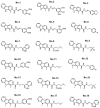Antiviral Activities of Carbazole Derivatives against Porcine Epidemic Diarrhea Virus In Vitro
- PMID: 34960796
- PMCID: PMC8703851
- DOI: 10.3390/v13122527
Antiviral Activities of Carbazole Derivatives against Porcine Epidemic Diarrhea Virus In Vitro
Abstract
Porcine epidemic diarrhea virus (PEDV), an enteric coronavirus, causes neonatal pig acute gastrointestinal infection with a characterization of severe diarrhea, vomiting, high morbidity, and high mortality, resulting in tremendous damages to the swine industry. Neither specific antiviral drugs nor effective vaccines are available, posing a high priority to screen antiviral drugs. The aim of this study is to investigate anti-PEDV effects of carbazole alkaloid derivatives. Eighteen carbazole derivatives (No.1 to No.18) were synthesized, and No.5, No.7, and No.18 were identified to markedly reduce the replication of enhanced green fluorescent protein (EGFP) inserted-PEDV, and the mRNA level of PEDV N. Flow cytometry assay, coupled with CCK8 assay, confirmed No.7 and No.18 carbazole derivatives displayed high inhibition effects with low cell toxicity. Furthermore, time course analysis indicated No.7 and No.18 carbazole derivatives exerted inhibition at the early stage of the viral life cycle. Collectively, the analysis underlines the benefit of carbazole derivatives as potential inhibitors of PEDV, and provides candidates for the development of novel therapeutic agents.
Keywords: antiviral drug; carbazole derivatives; porcine epidemic diarrhea virus.
Conflict of interest statement
The authors declare no conflict of interest.
Figures







References
-
- Su M., Li C., Qi S., Yang D., Jiang N., Yin B., Guo D., Kong F., Yuan D., Feng L., et al. A molecular epidemiological investigation of PEDV in China: Characterization of co-infection and genetic diversity of S1-based genes. Transbound. Emerg. Dis. 2020;67:1129–1140. doi: 10.1111/tbed.13439. - DOI - PMC - PubMed
Publication types
MeSH terms
Substances
Grants and funding
LinkOut - more resources
Full Text Sources

